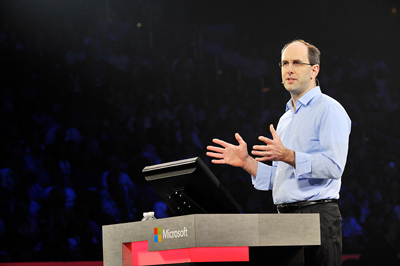Channel Watch
Microsoft Positions Azure as the Hyper-Scale Cloud To Beat
Microsoft is making major strides against Amazon and Google under the flag of "cloud first."
- By Scott Bekker
- September 10, 2014
Partners who had any doubt that Microsoft is deadly serious about winning with the Microsoft Azure cloud should've had those doubts put to rest by Scott Guthrie and Mark Russinovich.
Guthrie is the numerical replacement for Satya Nadella. Guthrie essentially stepped up to the role of executive vice president for the Cloud and Enterprise Group when Nadella left it to move into the office of the CEO.
In a keynote at the Microsoft Worldwide Partner Conference (WPC) in July, Guthrie dedicated several minutes to sketching out Microsoft's investments in Azure. The picture he drew was staggering.
First, Guthrie's comments drew a straight line from those by former CEO Steve Ballmer of a year ago. At WPC 2013, Ballmer revealed that Microsoft had more than 1 million servers in its datacenters, and contended that in terms of public cloud datacenter scale, it's a three-horse race among Google, Microsoft and Amazon.
Here's Guthrie this year: "Ultimately, we think there's going to be three large hyper-scale providers out there in the world that are going to be able to achieve this type of scale footprint: basically us -- Microsoft -- Amazon and Google."
 Microsoft's Scott Guthrie at July's Worldwide Partner Conference.
Microsoft's Scott Guthrie at July's Worldwide Partner Conference.
Guthrie also developed a point Ballmer made the year before. Where Ballmer differentiated Microsoft as being the only company simultaneously investing in private cloud, Guthrie elaborated that Azure delivers three overlapping circles of capabilities: hyper-scale, enterprise-grade and hybrid.
Where Guthrie broke new ground was in providing the positively spooky details of Microsoft's scale and redundancy.
According to Guthrie, Microsoft is now up to 17 Azure "regions" around the world. And what is a region? Imagine a datacenter building the size of a football field. But a region isn't one datacenter building, it's a cluster of them -- up to 16 buildings close together. Each region could theoretically include 600,000 servers, Guthrie says.
For a little back-of-the-envelope math (mine, not Guthrie's), were Microsoft to fill all those regions to capacity with servers, it would have more servers than the entire industry shipped in 2013.
"[That] gives you a sense of the scale and capacity that you can bet on when you choose Azure," Guthrie said. For comparison, Guthrie said Microsoft has two times as many regions as Amazon Web Services and five times as many public regions as Google Cloud.
Another high-profile Microsoft spokesperson, Technical Fellow Mark Russinovich, sounded the same drum in a different way in a keynote at the TechMentor Conference in Redmond, Wash., in August.
"Amazon Web Services is struggling in the face of pricing pressure by us and Google," Russinovich said. "People are starting to realize we're in it to win."
Are you betting any part of your business on Azure? Let me know why or why not at [email protected], or leave a comment below.
More Columns by Scott Bekker:
About the Author
Scott Bekker is editor in chief of Redmond Channel Partner magazine.